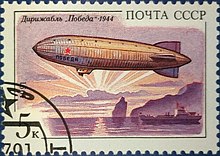Pobeda (airship)
The airship Pobeda ( Russian Победа , in German "Victory") was built in 1944 in the Soviet Union . Its main job was to transport hydrogen and cargo for the Soviet airship divisions of the parachute troops . Airships (e.g. field airships ) were not necessarily equipped with airships, but mostly operated balloons . At that time, parachute training for airborne troops was carried out from the balloons in order to save fuel for aircraft. The volume of the "Pobeda" was 5000 m³.
From February 20, 1945 to January 24, 1947, the airship made a total of 99 trips with a total duration of 285 hours and 10 minutes. A total of 15,315 km was covered. During 26 of these trips, the airship transported a total of 16,900 m³ of hydrogen gas from the Moscow Electrolytic Works to Pavlovskaya Sloboda and Zvenigorod (20 to 50 km from Moscow) or to Teikowo and Ivanovo, which are 200 to 500 km from Moscow. On each voyage, 900 m³ of hydrogen were transported in gas bottles or in balloon envelopes (in additional balloon envelopes or the envelope of the ship - source not clear). A total of 4433 kilometers were covered on these trips.
Service on the Black Sea
In September 1945 the "Pobeda" was relocated to the Black Sea . For this she was driven from Moscow to Sevastopol. There the ship was made available to the commander of the Soviet Black Sea Fleet , Rear Admiral Filip Sergejewitsch Oktjabrskij (1899-1969). The captain of the airship was Captain Roschin.
The Pobeda sailed the Black Sea for the first time on September 26th. This trip took 4 hours and 20 minutes. The airship was needed to search for mines . Three trips (a total of 30 hours) were also made to search for schools of fish for fishing. Fish specialists, so-called ichthyologists , were on board. On some occasions, the airship stood motionless over the school of fish without affecting the fish.
The Pobeda made 20 voyages over the Black Sea with a total duration of 113 hours and 30 minutes. It covered 5500 kilometers. From September 26th to October 20th, 15 trips were made from Kilenbalka (in Sevastopol ) over a total distance of 2860 kilometers.
Accident in January 1947
On January 29, 1947, during a trip to Ivanovo, the low-altitude airship collided with the high-voltage line at Jurjew-Polski . The wires in the line prevented us from continuing our journey. The engines were then stopped. The captain decided to throw ballast in order to free the ship from the line. After about 500 kg of ballast had been dropped, the ship began to climb quickly to 1000 meters. The overpressure valves in the shell were unable to compensate for the pressure rise inside the shell quickly enough after the impact height had been reached, so that the shell tore. The crew, which consisted of Captain Roschin, Lieutenant Mutovkin and the mechanic Starschina (~ Sergeant) Murashko, was not equipped with parachutes and fell to their death.
See also
- Russian airships
- CCCP-B6 - the largest Soviet airship
Web links
- Дирижабль «ПОБЕДА». Retrieved May 12, 2016 (Russian, history and photos).
- ОВД ВДВ: Дирижабль "Победа" (1944). Retrieved on May 12, 2016 (Russian, photo series).
Individual evidence
- ↑ Reinhardt Becker: The Russian and Soviet aviation . In: Wolfgang Sellenthin (Ed.): Fliegerkalender der DDR 1974 . Military Publishing House , Berlin 1973, p. 194 .
